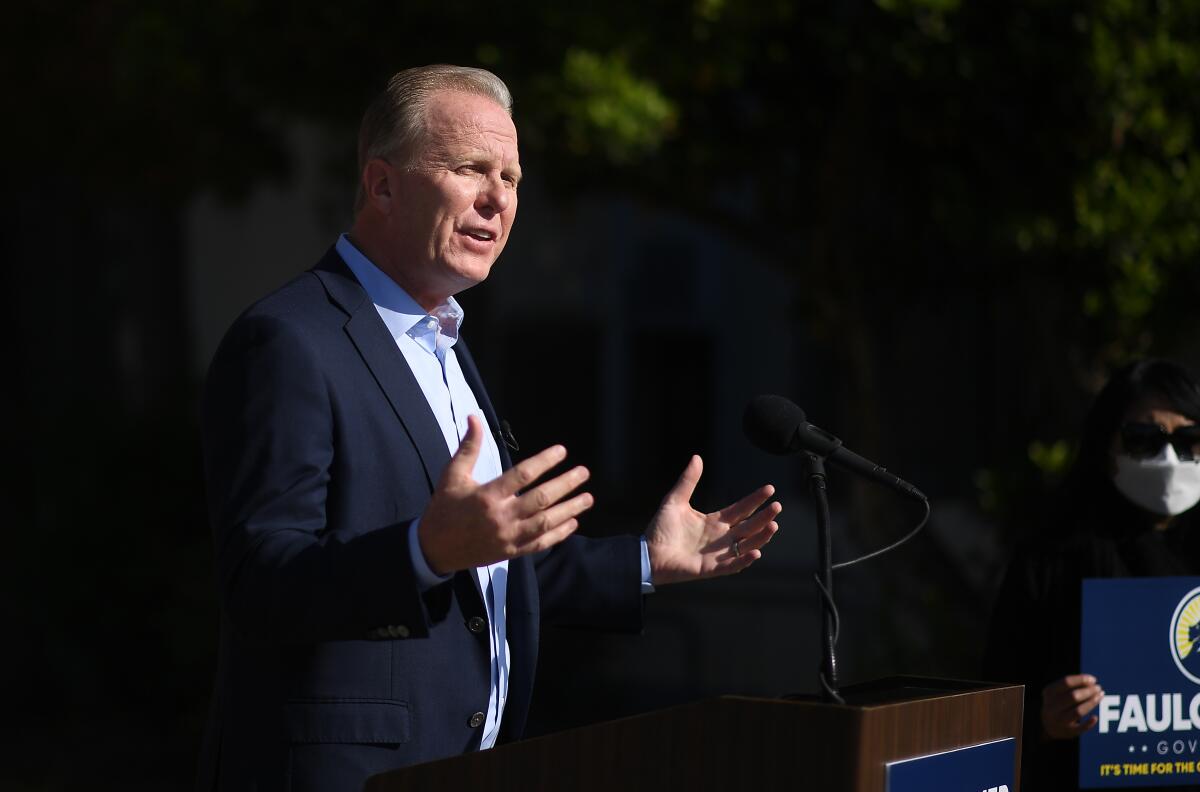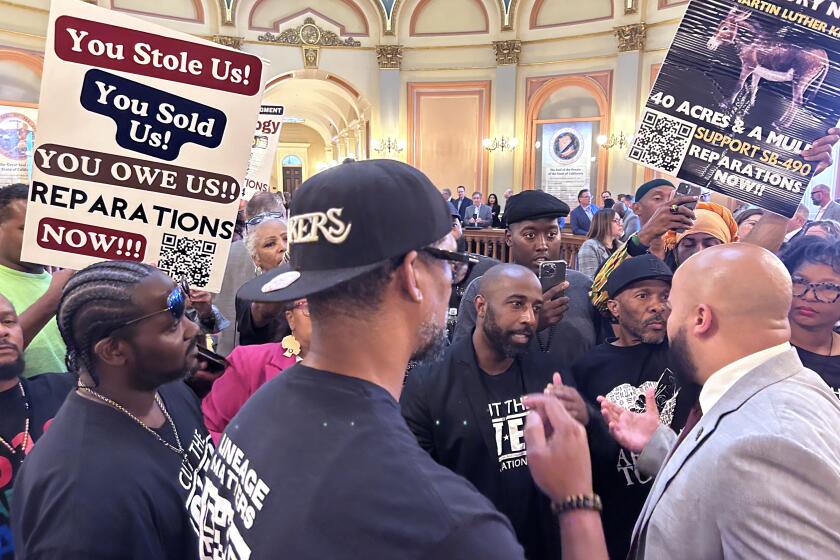Newsom recall rival Kevin Faulconer unveils plan to address homelessness

- Share via
Republican gubernatorial hopeful Kevin Faulconer released a plan to address homelessness on Tuesday that would couple the creation of more shelters across California with significantly stricter enforcement of no-camping laws in public spaces.
The former San Diego mayor’s proposal is modeled after actions he took in that city to reduce the number of people living on the street by 12% at a time when encampments were on the rise, but drew criticism for his reliance on law enforcement to clear them from sidewalks.
“I did not allow tent encampments on the sidewalk, because we care about people,” said Faulconer, who intends to run in the recall election to replace Gov. Gavin Newsom. “If you let people live in a tent on your streets and sidewalks, you’re condemning them to die in that tent.”
Under his plan, Faulconer would use an executive order to form a state-run network of temporary shelters on state property and push for a “right to shelter” law that could allow local governments to bar people from sleeping in streets, parks and other public spaces once they have been offered a shelter bed.
He also proposes extensive clearing of homeless encampments, facilitated by homeless outreach workers and local law enforcement who would encourage unhoused people to accept shelter and services. Those who refuse would face citations or arrests.
The six-page document does not provide cost estimates but calls for a mix of federal and local funding, and an ongoing stream of state dollars. Permanent housing would be prioritized for the state’s 11,000 homeless veterans, and government-run mental health programs would receive an audit.
“I believe that every human being has a right to shelter, and when we provide that shelter you have an obligation to use it,” Faulconer said. “The status quo under this governor is absolutely failing, and we need to intervene to help people dealing with mental illness or addiction get into a place where they can actually get up.”
An estimated 160,000 people are homeless in California according to point-in-time counts, a population that has grown by over 39% over the last five years and disproportionately affects low-income Black and Latino Californians.
Last week, Newsom finalized an agreement to spend a record $12 billion to address homelessness, in part to expand a program to convert vacant motels and other buildings into permanent housing. It also includes a flexible funding stream to local governments at a cost of $1 billion a year.
Launched during the COVID-19 pandemic, Project Homekey created nearly 6,000 new units of housing at roughly half the per-unit costs of new construction. Last year, the governor also called for a constitutional amendment that would force cities and counties to house homeless Californians.
Another Newsom recall challenger, Republican John Cox, revealed his plan to alleviate homelessness this week.
He also called for additional enforcement of laws prohibiting public camping and drug use, blaming the state for its “Housing First”-oriented homeless policy that does not predicate permanent housing on resolution of mental health or substance use issues.
As mayor, Faulconer began taking action on homelessness following a 2017 deadly hepatitis A outbreak. In his list of accomplishments, Faulconer touts moving some 1,000 unsheltered people to the San Diego Convention Center early on in the pandemic and placed hundreds in permanent housing.
John Brady, a member of the San Diego Regional Task Force on the Homeless who lived through a period of homelessness himself, says Faulconer deserves credit for the program. But he believes the mayor relied too heavily on enforcement strategies that had serious negative impacts on people, including trauma and isolation from support networks.
“Mayor Faulconer came from a public relations background. I’m not critical of people that work in PR, but if you want to ameliorate the visible problem, the easiest way to do that is to disappear people living on the streets,” Brady said. “It doesn’t solve the underlying issues.”
Shelters, Brady said, can be “sort of like a prison without the bars but all of the rules.”
Even once a person accepts shelter, any mental health or substance use issues are unlikely to get resolved without permanent supportive housing, he said.
UCLA professor of law emeritus Gari Blasi pointed out that temporary shelters are more costly than housing, and called Faulconer’s plan “the most cynical way to respond to the court restriction of bulldozing encampments.”
“Trying to deal with this with police and shelters will not remove all the people who are living outdoors,” said Blasi, who specializes in public interest policy and law with a focus on homelessness. “But it will move them from one place to another and typically to a place where neighbors have less political influence.”
Whatever the prescription, it’s clear California voters want politicians to prioritize homelessness and housing affordability. In a survey by the Public Policy Institute of California conducted just before the pandemic took hold, homelessness was named the top issue for Sacramento to address by 23% of likely voters.
The governor and his recall challengers are likely to have a shorter timeframe to convince voters of the virtue of their plans now that lawmakers approved legislation to expedite a vote. An election date is expected to be set as early as this week.
More to Read
Sign up for Essential California
The most important California stories and recommendations in your inbox every morning.
You may occasionally receive promotional content from the Los Angeles Times.











